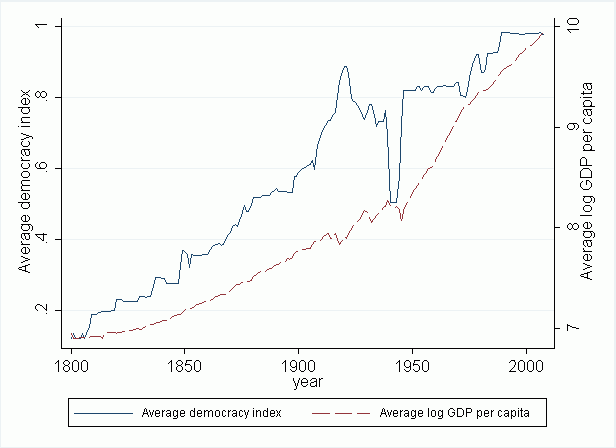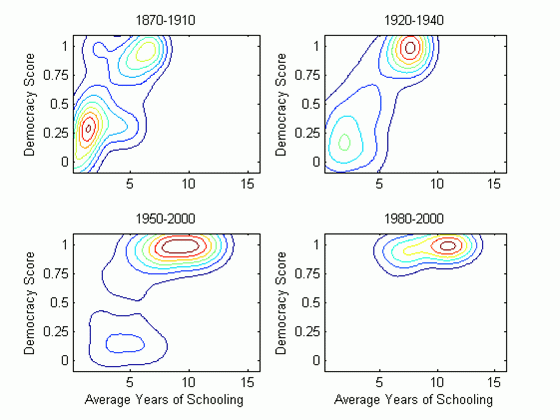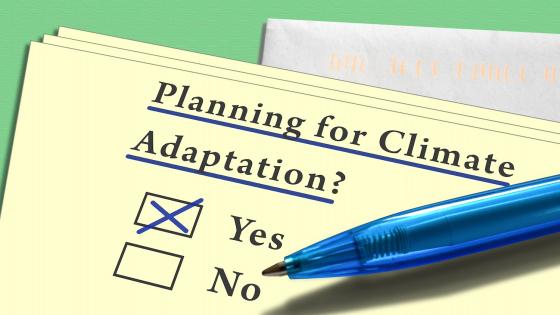Throughout history the march toward political freedom has not been a smooth process. It has happened in fits and starts, in waves, and was often reversed or interrupted. The collapse of several Middle Eastern authoritarian regimes in the wake of this year’s Arab Spring illustrates the point clearly.
Political institutions have undeniably progressed from autocracy to democracy over the last 200 years. Figure 1 displays this democratic transition by plotting over time a commonly used index of democracy (the Polity IV democracy score, rescaled between 0 and 1), averaged for a balanced panel of 14 countries since 1800. The figure illustrates some fits and starts – for instance the interruption of the march to democracy during the interwar period – but also a generalised upward trend. Like the demographic transition, economic modernisation, and the globalisation of human activities, democracy seems to have pursued an inexorable march.
Figure 1. The democratic and economic transitions
Note: (Balanced sample composed of Austria, Belgium, Chile, Denmark, France, Japan, Netherlands, Norway, Portugal, Spain, Sweden, Turkey, the UK, and the US over 1800-2000).
What factors determine the transition toward democracy and its durability? This is a classic question in political economy, but not one that has yet been resolved. On the eve of the 19th century, Thomas Jefferson was defending the view that mass education was the “the most effectual means of preventing tyranny” (Jefferson 1779). In line with the Founding Fathers’ vision, the US turned into a leading country in terms of educational attainment, leading Alexis de Tocqueville (1835) to note in Democracy in America that “the education of the people powerfully contributes to the maintenance of the democratic republic”. The idea that the accumulation of human capital and economic modernisation more broadly create the conditions for sustained democratisation found a more recent consecration in the writings of Seymour Martin Lipset, who in 1959 introduced the ‘modernisation hypothesis’, arguing that economic development is a precondition for democracy. While international comparisons initially supported this hypothesis (Barro 1999), scholars still debate the issue, as many argue that causality runs instead from institutions to development.1
Does democracy affect education and income or is it the other way around?
Whether democracy affects education and income or whether the causality runs the other way is the key source of disagreement in this debate. Studies examining the consequences of democratisation uncovered mixed results. On the one hand, Lindert (2004) argued that the extension of the suffrage led to mass educational systems at the turn of the 20th century. On the other hand, studies that examine the effects of democracy over the more recent period found weak effects of democracy on economic growth across countries (Tavares and Wacziarg 2001), and weakly positive within-country growth effects, but only in the short run (Rodrik and Wacziarg 2005). Studies that focus on short-run effects using relatively recent data, however, face difficulties in convincingly establishing the direction of causality between democracy and economic modernity, calling for a longer-run approach.
In a recent paper, we revisited the drivers of the democratic transition and the debate over the direction of causality linking education, income and democracy (Murtin and Wacziarg 2011). The novelty of our approach is to use data that goes back to 1870, using ten-year time spans between observations to capture long-run relationships. Another novelty is to use a unique historical dataset on educational attainment from Morisson and Murtin (2009), allowing us to run a horserace between education and income as drivers of the democratic transition.
Our first step is to document the democratic transition over the long run. Figure 2 displays the joint distribution of the democracy score and of the average years of schooling since 1870 among a balanced panel of countries. The graph shows a steady transition from low schooling and low democracy to high schooling and high democracy. Democratisation and the accumulation of human capital have clearly gone hand in hand though history, but what remains unclear is the direction of causality linking these two transformations, or whether a third factor drove both.
Figure 2. The joint distribution of democracy and average years of schooling since 1870
The direction of causality can be assessed using modern dynamic panel data methods applied to the long-term historical data. These statistical methods allow us to control for third factors that might drive both democracy and modernity, and to use the dynamics of the relationship over the long run to disentangle whether modernity (measured alternately by income per capita or educational attainment) affects democracy or the other way around. We found empirical support for the modernisation hypothesis over the long run – ie that both income and education affect democracy. The data reveal another key finding. The rise in primary education has been the main driver of democratisation over 1870-2000. While income per capita plays an important role, primary education is a both quantitatively more important and statistically more robust determinant of democracy. It also trumps education at the secondary and higher levels as a prime determinant of democracy. The global transition towards full literacy, which was completed in most advanced countries at the end of the 19th century, largely explains the historical rise in democracy. On the other hand, using the same methodology, we found little evidence that democratisation led to higher educational attainment or faster long-term growth once controlling for the level of income.
The Arab Spring was partly predictable
Returning to recent events, the Arab Spring was partly predictable, as Middle Eastern countries displayed levels of democracy that were lower than those predicted by their level of education and income. Figure 3 focuses on these countries in particular, showing that their levels of democracy as predicted by our empirical model lie above their pre-2011 actual levels. In other words, the Arab Spring could be expected based on a dynamic statistical model of the factors that drive democracy (interestingly, the same observation holds for Iraq and Cuba). Figure 3 also gives cause for caution, however, as only modest improvements in the democracy scores should be expected to endure for these countries. The real key to democratisation lies in slow-moving fundamental forces such as income and education. We should not expect Middle Eastern countries to achieve high and sustained levels of democratisation until they more fully embrace economic modernity.
Figure 3. Model-predicted and actual levels of democracy, 2000
References
Acemoglu, D., S. Johnson, J. A. Robinson and P. Yared (2005). "From Education to Democracy?" American Economic Review Papers and Proceedings, vol. 95, no. 2, pp. 44-49.
Acemoglu, D., S. Johnson, J. A. Robinson and P. Yared (2008). "Income and Democracy." American Economic Review, vol. 98, no. 3, pp. 808-842.
Barro, R. J. (1999). "The Determinants of Democracy." Journal of Political Economy, vol. 107, pp. S158-S183.
Benhabib, J., A. Corvalan, M. Spiegel (2011). "Reestablishing the Income-Democracy Nexus." NBER Working Paper 16832.
Bobba, M. and D. Coviello (2007). "Weak Instruments and Weak Identification in Estimating the Effects of Education on Democracy." Economics Letters, vol. 96, no. 3, pp. 301-306, September.
Jefferson, T. (1779). A Bill for the More General Diffusion of Knowledge, Bill 79 in Report of the Committee of Revisors Appointed by the General Assembly of Virginia in 1776. Richmond, VA: 1784.
Lindert, P. (2004). Growing Public. Cambridge University Press.
Lipset, S.M. (1959). "Some Social Requisites of Democracy: Economic Development and Political Legitimacy." American Political Science Review, vol. 53, pp. 69-105.
Morrisson, C. and F. Murtin (2009). "The Century of Education." Journal of Human Capital, vol. 3, no. 1, pp. 1-42.
Murtin, F. and R. Wacziarg (2011), "The Democratic Transition." NBER Working Paper 17432.
Rodrik, D. and R. Wacziarg (2005). "Do Democratic Transitions Produce Bad Economic Outcomes?" American Economic Review Papers and Proceedings, May 2005, pp. 50-55.
Tavares, J. and R. Wacziarg (2001). "How Democracy Affects Growth?" European Economic Review, vol. 45, no. 8, pp. 1341-1379, August.
Tocqueville, A. (1835). Democracy in America. Penguin Classics.
1 See in particular Acemoglu et al (2005 and 2008), Bobba and Coviello (2007) and Benhabib et al (2011).






